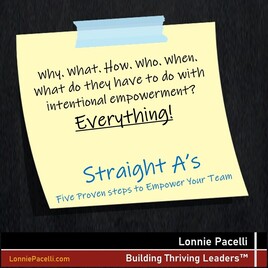 As of this article, my wife and I are in process of buying a car. We are looking for a very specific model with “must-have” features, like exterior color and interior appointments. At one dealer in particular, the salesperson was clearly trying to endear himself to me, wanting to talk about things that I wouldn’t generally talk about with someone I just met—and had nothing to do with buying a car. Now, I’m a relational guy and love to learn more about people—but I can also tell when someone is manipulating me. His dis-ingenuousness made me not want to work with him. I was looking to buy a car and wanted to stay focused on what needed to be done to buy the car, but the salesperson was trying to work me. I ended up walking away and will avoid doing business with the salesperson in the future. You might be asking what buying a car has to do with being a project manager. So much of what a project manager does is about relationships—guiding and working with others to deliver something on time, on budget, and within scope. However, relationships aren’t one size fits all. Depending on the situation and the parties involved, I’ve found that relationships can take on one of three forms, as follows: Read more at ProjectManagement.com.
0 Comments

So maybe you think you're all that and a bag of chips and that you can get more things done than most people in your organization. As managers, though, it's not just about you getting things done on your own; it's about you getting your team to be as effective (or more) as you.
I deliberately use the term effective versus efficient. For me, there is a very clear distinction which I believe is crucial in driving results. Micromanage: to manage or control with excessive attention to minor details Source: dictionary.com  I’ve been a micromanager, been micromanaged, and advised clients on how to avoid micromanaging and being micromanaged. To help peel back the onion on micromanagement and what to do about it, I’d like to start with a concept in my book, Straight A’s, that empowers followers. The Straight A’s focus on five core steps, as follows:
For this to work, both the leader and the follower have to do their parts in each step of the process. For each of the steps, here are responsibilities for both leaders and followers: Read more at ProjectManagement.com. 
Bud was one of the most brilliant people in his organization. Only in his mid-thirties, Bud amazed his senior managers with his ability to grasp problems and develop innovative and effective solutions to those problems. He was highly sought after as a "go-to" guy and would consistently come up with creative approaches. His management decided to give him a thorny project with a team of over 100 professionals. "This is my chance to really prove I can deliver", Bud thought as he willingly accepted the project.
Bud wasted no time in coming up with some great solutions which his management thought were brilliant. Expectations were sky-high and Bud was on a project high. Then the problems started. 
When I was a kid in Connecticut I went with my Father to take my sister and her infant son to the train station. My sister had a lot of bags so my Father helped her carry her things on to the train. I was standing on the platform waiting for my Father to get off the train so we could go home. Then all of a sudden the train started moving with my Father still on the train! Here I am, an 8-year-old boy standing on the train platform all by myself while my Father is on the train heading to Washington DC. I remember seeing the train start to pull away, and my Father waving at me through the window to go to the ticketing office so I can tell them what happened. This was in the days where there were no cell phones, so my Father couldn't communicate with me to let me know what was happening. I went into the ticketing office and through sobs told the ticket agent that my Father got stuck on the train and I got left on the platform all by myself. The ticket agent was very reassuring and told me that everything was going to be OK. Fortunately the next stop was only about 30 minutes away so I was reunited with my Father in an couple of hours. It was one of the scariest times of my entire childhood, being left on the train platform all by myself.

Some time back I spent about three hours writing and doing emails at one of our local malls. I love this place because there are lots of tables to sit at and the mall has free wireless access so I can be online all the time. As I was exiting the mall I noticed a woman about 20 feet away from the entrance heading into the mall. As I walked out the door I held the door open for this woman for a few seconds. As she walked by me into the mall she said "WOW!" She was surprised that I actually took three seconds out of my life to hold a door open for a complete stranger. Imagine what I could have done with those three seconds that I wasted :-).

Project management is changing….it's becoming more strategic, more mainstream, and not just synonymous with technology implementations. Today's PM needs to be more than technically adept or be able to whip out a gantt chart. Get a read on some of these crucial skills the everyday PM will need to succeed:

It's happening more and more; managers are being asked to manage virtual teams of people that may or may not have a direct reporting relationship to the manager. Some find it easy to do, but many others find it difficult to garner the respect from team members who don't have to follow the manager. Get a few helpful tips to help you next time you're asked to manage a virtual team.
|
Topics
All
Reprints
Contact Lonnie about article reprints. Please specify article you wish to reprint. Backlist
See Lonnie's Amazon Author Page Archives
July 2024
|
Lonnie Pacelli - Building Thriving Leaders™
Insightful | Creative | Direct Advice to Help Leaders Help Themselves
Keynote Speaker | Board Director | Autism Advocate | Author | Project Management Expert | Microsoft/Accenture Veteran
See his books on Amazon
Insightful | Creative | Direct Advice to Help Leaders Help Themselves
Keynote Speaker | Board Director | Autism Advocate | Author | Project Management Expert | Microsoft/Accenture Veteran
See his books on Amazon
Services |
About
|
© COPYRIGHT 2019. ALL RIGHTS RESERVED.
We are a participant in the Amazon Services LLC Associates Program, an affiliate advertising program designed to provide a means for us to earn fees by linking to Amazon.com and affiliated sites.
|



 RSS Feed
RSS Feed